Inside: Cooking with cast iron is a safe and non-toxic alternative to using nonstick cookware. Here’s a step-by-step tutorial for restoring and re-seasoning a cast iron skillet or pan–even if they are full of rust!
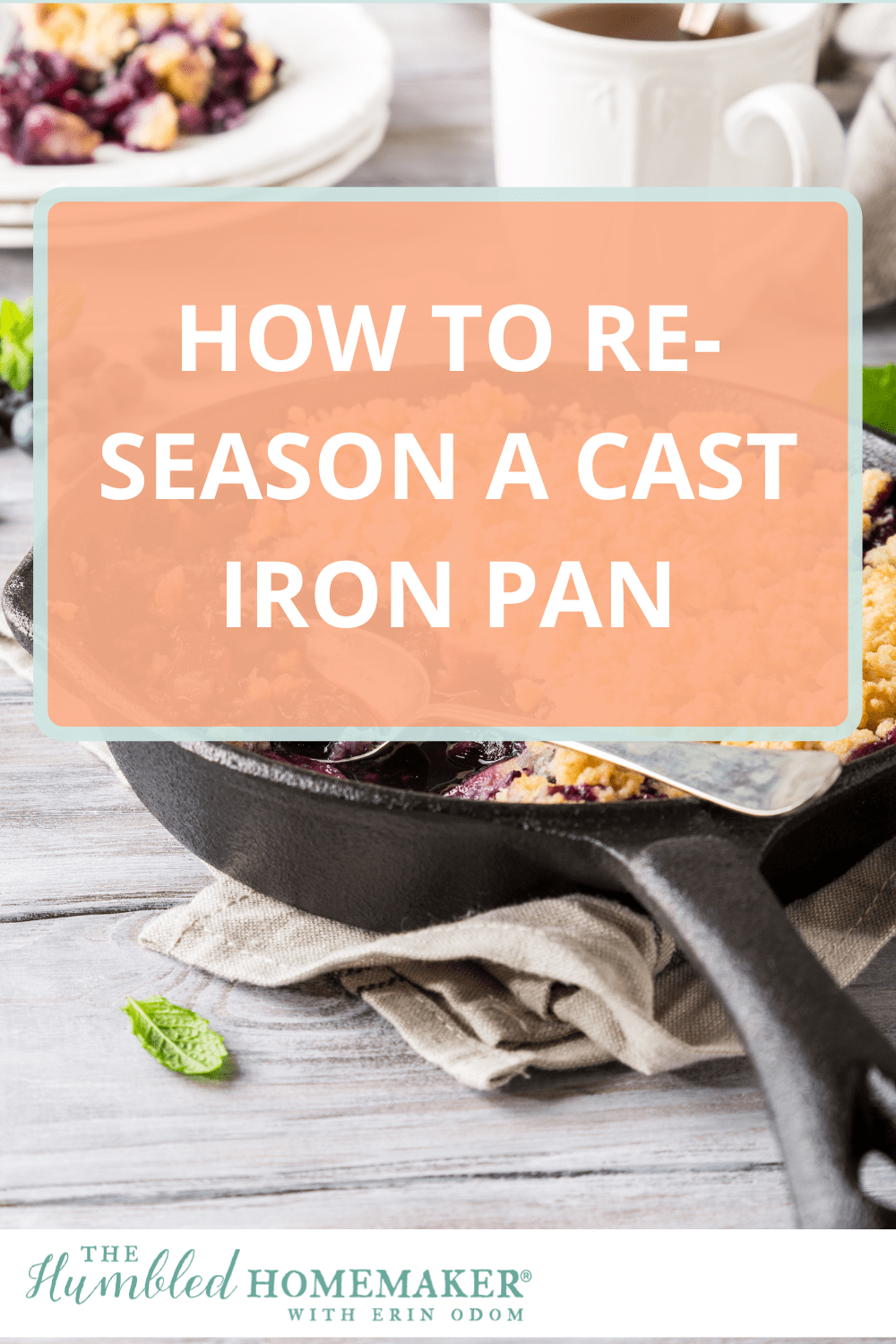
Related: 20 Kitchen Gadgets and Tools You’ll Actually Use and Love
By Asheritah Ciuciu
If you have old, rusty cast iron pans that look hopeless, don’t despair! Today I’ll show you how to re-season a cast iron pan, so that you can swap out the dubious nonstick pans with healthy cookware that literally shines.
Why Bother With Old Cast Iron Pans?
I struggled with yo-yo dieting for years, hopelessly caught in a cycle of gaining and losing the same 10 pounds. Part of my journey toward overcoming food addictions included swapping out lies for Truth and unhealthy ingredients for healthy ones.
When I read about the dangers of nonstick pans, and that old cast iron pans can be restored to their former glory, I grabbed a pair. Old pans are cheap, easy to find, and durable additions to your kitchen.
Related: 7 Kitchen Appliances You Really Don’t Need
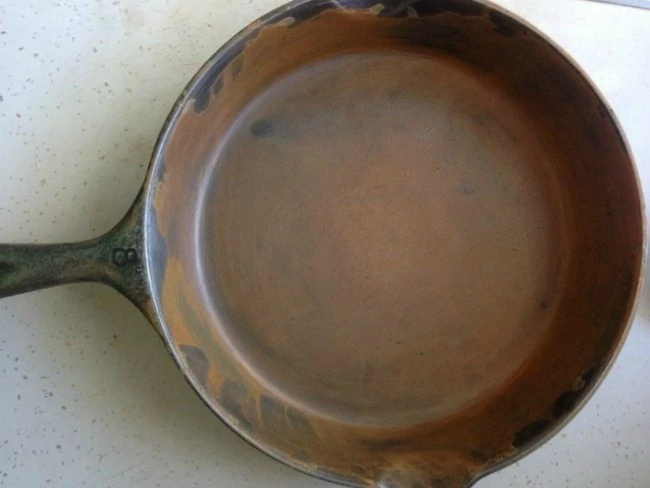
How Hard Is It to Re-season a Cast Iron Pan?
Lots of online directions recommend using a toxic oven cleaner, but you can easily restore a pan with natural methods as well. Depending on the condition of your pan, this process may take 20 minutes to two to three hours of active work, plus baking time. But once you re-season a pan, the nonstick coat will last for years, making your favorite recipes that much healthier.
The Easy (Natural) Way to Re-season a Cast Iron Pan
Related: 4 Kitchen Staples to Always Keep On Hand
1. Clean the Pan.
Scrub the pan with steel wool or coarse salt and a potato to remove all rust and cooked-on gunk. Then rinse with warm water and soap, if desired, and move quickly to step 2.
Expert tip: Be generous with the salt. Some of the salt will get stuck in the potato, so you’ll want to have enough left over to really scourge the pan of all rust.
Related: 10 Homemade Kitchen Cleaners
2. Dry the Pan Immediately.
As soon as you’ve removed the pan from the water, dry it thoroughly with a cloth towel and warm it on medium-low heat to evaporate all moisture. While your pan is warming, place aluminum foil on the bottom rack of your oven to catch any drips. Heat oven to 500 F (or your highest setting).
Expert tip: Make sure you move to Step 2 immediately. I can’t emphasize this enough. Don’t wait 5 minutes, like I did, because rust will already begin to develop on the surface of the pan.
3. “Bake” the Pan.
Place the cleaned, dry pan in the oven and bake for one hour, un-oiled at first. This will allow the pores to open up and better soak in the oil in the next step.
Related: 5 Tips for Getting Kids to Help In The Kitchen
4. Season the Pan with Oil.
Carefully remove the pan from the oven, using double oven mitts if necessary. Immediately rub a coat of oil all over the pan (inside and out) with a wadded paper towel or cotton cloth; the hot cast iron will absorb the oil into its pores and within minutes you’ll begin noticing a sheen.
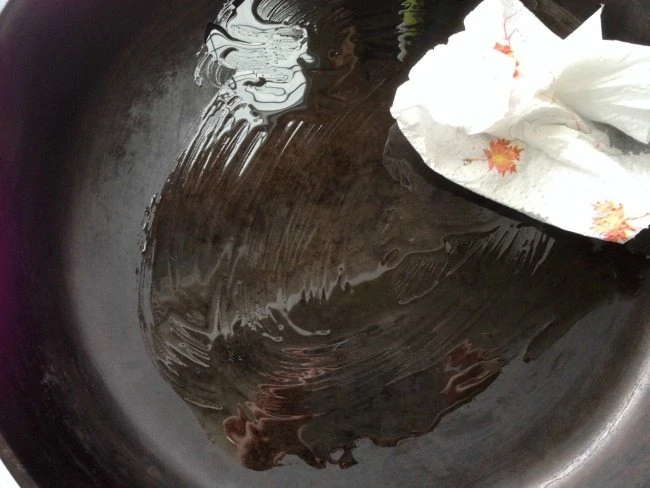
Keep rubbing oil into the metal until it begins to build up, then use new paper towels to wipe up excess oil until the pan just looks wet. Be very careful to avoid burning yourself. (The oil may smoke, but that’s ok.)
Expert tip: You can use olive oil, lard, or any other oil you want, but try to find a high smoke-point oil if you can. And open the windows; there will be some smoke. The second time around I used cottonseed oil, which was better than olive oil.
Related: Is a High Speed Blender Worth It?
5. Return Pan to Oven.
Turn off the oven and return the pan to the oven, upside-down. Every 10 minutes or so, wipe the pan to catch any build-up of oil drips before they bake on, and return to the oven. After 30 minutes, prop the oven door partially open to cool.
6. Repeat (Maybe).
If your pan is in bad condition, you may need to repeat the seasoning method a few times to build up a nonstick base coat. Simply rub oil on the cool pan and bake upside down for one hour at 500 F, letting the pan cool in the oven.
Expert tip: You only need to rub oil into a hot pan the first time around; any further coats of oil go on a cool pan.
Related: 10 Essentials for a Healthy Kitchen
Do you cook in a cast iron pan? What tips have you found most helpful when restoring old pans?
BONUS: Get Your Free Holiday Menu Planner Printable
Get a free menu planning printable. Join my weekly-ish homemaking newsletter, and, as a bonus, you’ll get the printable PDF! Just click here to get it and subscribe.
Asheritah is a writer, speaker, and blogger at OneThingAlone.com. There, she helps overwhelmed women find joy in Jesus through devotionals. She’s also the author of multiple devotionals and Bible studies, including Prayers of Rest. In her spare time, she enjoys spending time with her children and trying out healthy recipes in the kitchen. Join her on her blog for a virtual streusel blueberry muffin and a welcoming community of women.

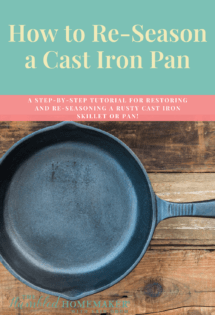
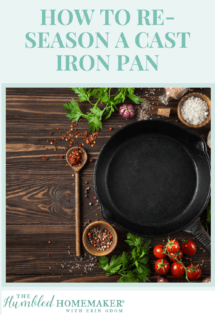
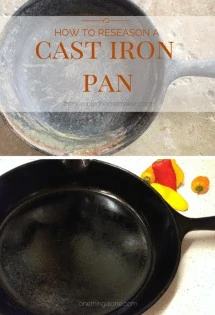
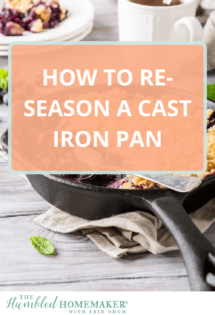
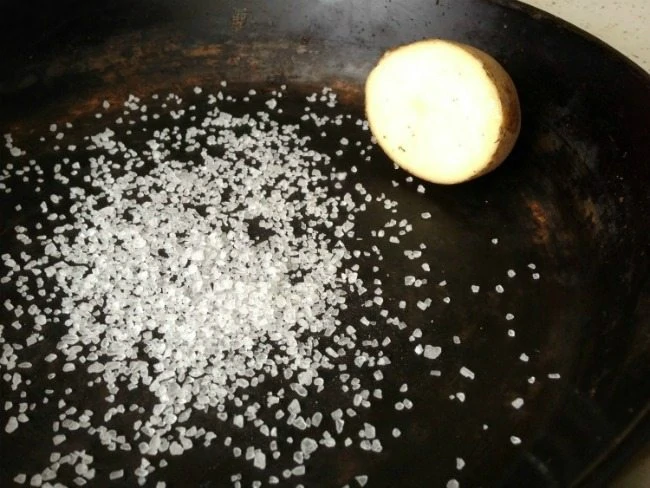
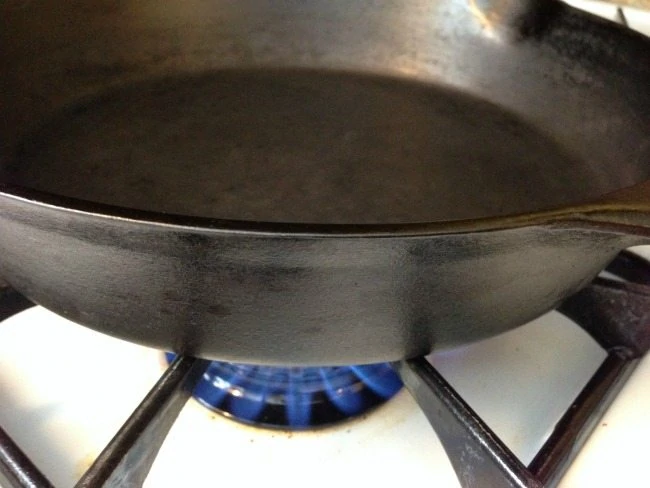
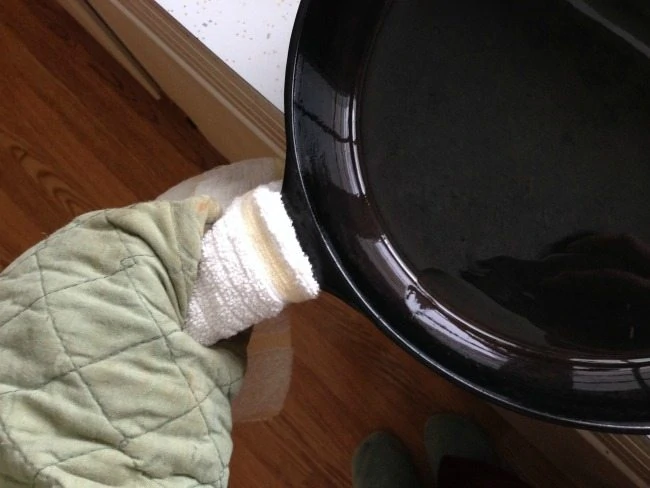
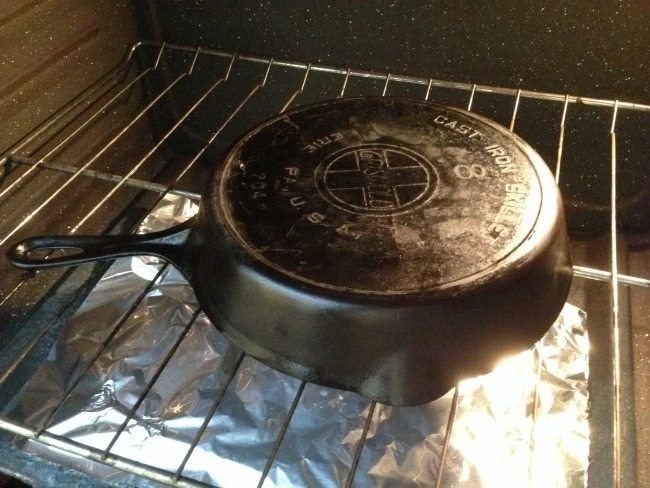
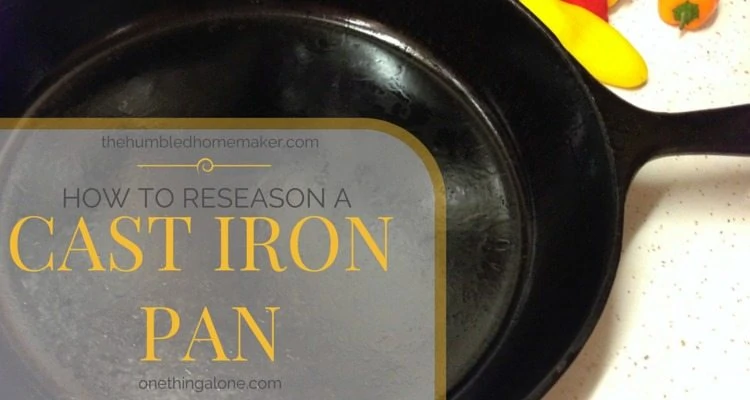
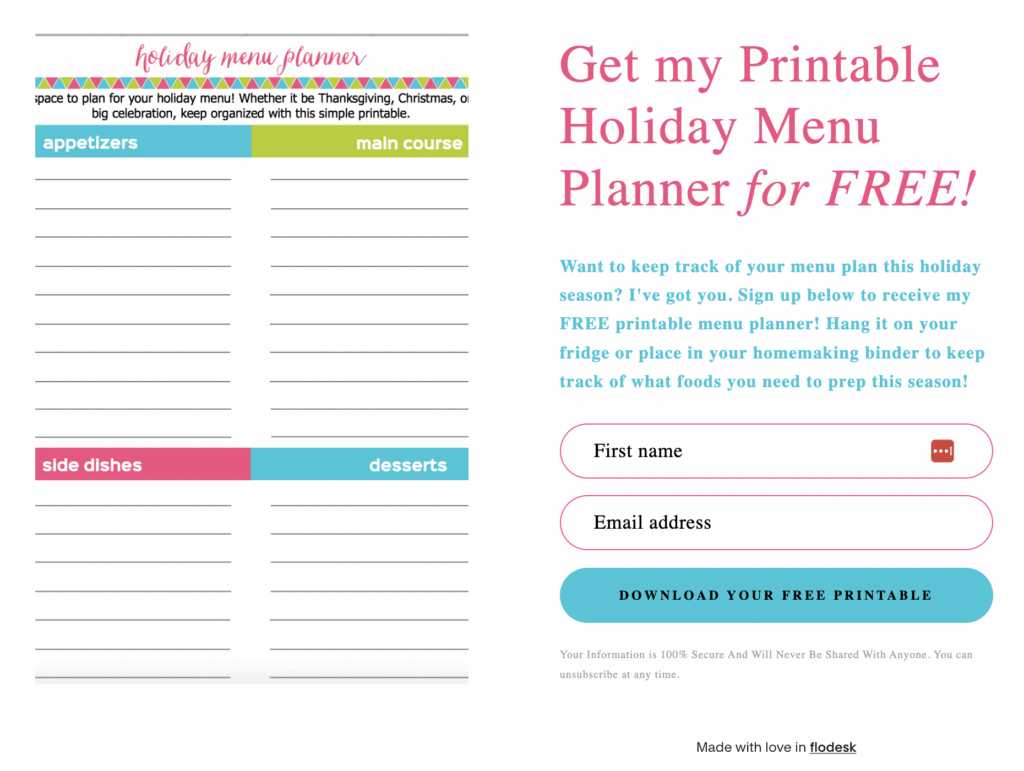


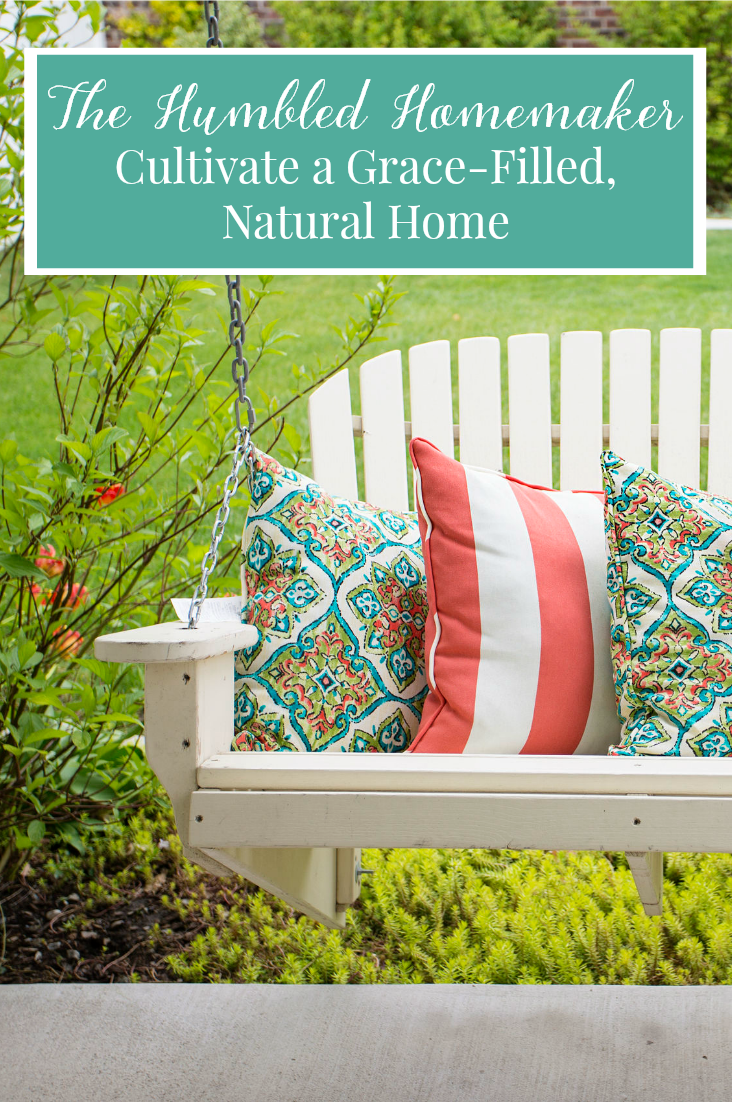

Jessica
Do you have to re-oil and bake after every use?
Asheritah
Hi Jessica! I don’t do the whole process every time I use it; simply heat it dry and then spread some oil in the pan to keep the coating fresh. Let me know if it works for you!
Lisa @ This Pilgrim Life
We have cast iron pans but caring for them has always seemed so daunting for me so I typically reserve them for camping!
Thanks for sharing these tips. Maybe I will be brave and learn something new today 😉
Asheritah
So glad you found the tips helpful! Give it a try and let me know how it works for you!
Kirsten
Thank you so much for this! I have my Gram’s old pan, and thought it couldn’t be used again, so I am def going to try this method! I am also going to re-season a dutch oven that has some gunk built up on it.
Asheritah
Let us know how it goes for you!
Lori Sorrells
I have been wanting to buy a cast iron pan, and they are not very expensive, but all of them seem to come “pre-seasoned”. I have no idea what they put on them, and so am wary of buying one. I can’t seem to find any info on what is used, and I can’t find pans that are not pre-seasoned. Does anyone know more about this? I would prefer to do my own seasonings so I know what kind of oil was used, and appreciate this article. Thanks so much!
Grammyprepper
Lori, just reseason if you’re worried about what they use to preseason the pans. Or else, look for used at thrift stores, yard sales etc. You’ll end up reseasoning those as well, but might be even less costly!
Karen
Actually, if you can get an older pan at a garage sale or antique sale and recondition it or especially one reconditioned already on eBay you’ll be better off. The older pans are generally very smooth and food doesn’t stick, even eggs. The new pans are considerably rougher, almost feel pebbeled. As long as it sits flat and doesn’t have cracks etc. they last practically forever so buying an old one is just fine.
Asheritah
Lori, like Grammyprepper said, you can strip the seasoning and do your own. Let us know how it works out for you!
Didi
They use soy oil for pre-seasoned pans bought in store. I bought unseasoned from some weird site and seasoned it from scratch with coconut oil. It’s up for reseason, some 5 years later.
Anita Keatts
I have found that washing with hot water, as hot as you can stand, and no soap helps to prolong the finish. Coating with a small amount of oil or cooking spray and wiping excess helps too.
Betty Moderno
I use my cast iron skillet to cook roasts in. That way, when I go to make the gravy, all the drippings I need are already in the pan and I have 1 less pan to clean up afterwards. I have one that is very old, and I have never had to re-season it because of rust.
Melissa
I love my cast iron! I use it for everything, baking, frying and on the grill (cooked a turkey on the grill in one, was delish), cooking over open fire. It is such a versatile tool and best part you can use whatever you have for utensils, no need for special ones. My kitchen will alway have cast, I have a friend that is now using them as well.
Jessica Sanders
This is timely. I went up on the mountain a week or so ago and cooked dinner and it started to rain heavy. I threw everything in the back of the truck and forgot to retrieve my cast iron when I got down. Thanks for the instructions. My pan iso rusted on the bottom too. I’m guessing you don’t rub oil on where you cook too. Am I right?
Jodie
Oh yes you do! Once you remove the rust, I use steel wool, kosher salt, scrub the heck out of it, rinse, dry throughly, heat, apply oil, heat and wipe off excess oil. Then after every use, I clean the pan without soap, dry it, heat it on the stove top then apply oil, let it cool and wipe off excess oil. And I oil every part of my pans Handel and bottom included. Just make sure to
Kyle
This is the best tutorial for restoring old cast iron I have found. I can’t say much for the potato salt method for the rust. The pans I restored required a heavy wire drill bit and all my weight to strip the pan of it’s seemingly decades of rust and burnt buildup. I got it done though and followed the rest of your instructions here. I found so many varying information from other sources about the temperature and I can indeed say that using the highest temperature is the way to go to properly so this. Also baking them beforehand is a good idea, I don’t think I saw any other source instruct that point.
Thank you for writing this out, it should be the first result for any search someone makes On this subject!
Kelly Eadie
This IS the best “How To” I’ve found! Even better than the CGR I got from Lodge Cast Iron when I needed help.
The ONE THING I REALLY NEED TO FIND ~ BUT CAN’T FIND ANYWHERE…
My Old Skillet has “SPOTTY” RUST on the cooking surface. It seems to be where the electric oven element makes contact with the bottom. The rest of the surface is well seasoned & intact.
My question is this: If I use steel wool to get the rust out, do I need to bring THE ENTIRE PAN down?? Or can I just do the areas that are rusting?? I’m thinking it will “Lift” the coating & allow rust to get in under the coating. BUT… MAYBE if I scour only the rust (and a little extra), THEN wash the entire thing & go STRAIGHT TO STEP 2, I think it should probably be alright. I’m still using the skillet & it’s fine to use. I wash it, dry it immediately, put it on the stove & turn the heat on to make sure it’s completely dry. Then I rub a super thin layer of vegetable oil on it while it’s hot & wait for it to smoke. Then I wipe it out with towel & let it cool on the stove top. I wipe out any excess oil before putting it away.
I’VE HAD THIS FOR ABOUT 25 YRS. THESE AREAS BEGAN ABOUT A YEAR AGO. THEY HAVEN’T GOTTEN ANY WORSE. At first, I thought it was from tomato sauce or something acidic like that. It doesn’t really LOOK like RUST. It’s redder.
IF ANYONE HAS AN ANSWER TO THIS ~ PLEASE SHARE IT WITH ME!! I WOULD TRULY APPRECIATE IT!
THANKS!
C BRYAN
This article is a godsend. I just finished running an oven cleaning cycle and opened the oven to find all my cast iron in there covered in rust flakes (I forgot they were there). I washed them and they are all gray so I decided to reseason. I had been wanting to do this, but the first step always kept me from doing it. Even though this was a mistake, I’m glad it happened this way because it made cleaning a breeze.
Anne Martin
I have found: if a large amount of cooked residue is stuck to the cast iron, fill with 1.5” of water and bring to a boil. Remove from heat. Let cool. Using metal, gently scrape residue. It should remove easily. To clean: steel wool works best. Always dry well and lightly oil after cleaning. Cast iron is amazing and so much healthier.
Erin
Thanks so much for this tip!
Kumar
Thanks for the article, Asheritah! I have a question, however. In step 5, you ask to turn off the oven before placing the pan. So the pan would just be in the oven, while it’s cooling down?
If so, under repeat, you ask to bake the pan at 500 F for an hour. Is that pre-heating the oven to 500 F, turning it off, and placing the pan in?
Sorry, I’m new to cast iron pans!
kg
I just am working on re-seasoning my cast iron skillet which was bad. I scraped it and used steel wool and then got it to look like your first photo. Unfortunately one seasoning it 3-4 times the skillet looks rust colored. Should I remove all seasoning again and restart or will it eventually turn black?
Thanks,
k
Thomas J Weaver
I have some cast iron skillets that have a hard, black crust on the outside and up the inside of the pans. How do you remove this? I have tried scrubbing with coarse salt and a scouring pad, chipping it and scraping it and I can’t remove it. Any suggestions?
Erin
Oh no! If you’ve tried everything, I’m not really sure. 🙁
Marilynn Myers
Please edit your suggestion to put foil on the bottom of the oven. I just melted the foil to the bottom of my oven and almost started a fire. Now, I must go through a painstaking process to remove the foil.
Will O
I’m sorry that happened Marilynn. The post reads the bottom rack of your oven, not the actual bottom of the oven. I also tend to use the heavy duty foil.
paul petry
A new seasoned pan is ruff. Should I grind it smooth before I start the seasoning process?
Thalia E. Young
Someone asked about a pan that was so crusty it could not be scrubbed clean. My son-in-law had one like this, and he cleaned it in the self-cleaning oven and then re-seasoned it. He warned that his smoke alarm did go off! LOL! This is sometimes the case with older pans which have been used on wood stoves and in camping out.